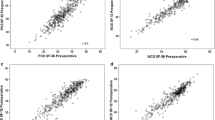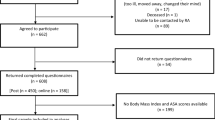Abstract
Purpose
To assess the measurement properties (acceptability, validity, reliability and responsiveness), of the MOS 36-Item Short-Form Health Survey (SF-36), the EQ-5D, the Short-Form McGill Pain Questionnaire (SF-MPQ) and the Musculoskeletal Functional Assessment Instrument (MFA), in patients who have undergone limb reconstruction surgery (LRS).
Methods
Four instruments measuring patient-reported outcome were completed at baseline and 12 months from surgery.
Results
101 LRS patients were recruited with 95 responding at baseline and 71 at a 12-month follow-up. Response rates at baseline were over 94%. In three instruments, there was evidence of floor or ceiling effect, the exception being the EQ-5D. Cronbach’s α statistics of internal consistency reliability were acceptable at ≥0.80 for all dimensions of the MFA, the SF-MPQ PRI(S) and seven of the SF-36 dimensions. When comparing mean changes in scores between baseline and 12 months, the most responsive measure was the SF-36 with an average Standardised Response Mean of 0.48 for those who reported their health as better. Statistically significant differences were observed between the health change groups (‘worse’, ‘better’ and ‘same’) for four dimensions of the SF-36, the two summary scores and the SF-6D.
Conclusions
Variation and poor performance of some of the instruments resulted in a recommendation of using the SF-36 and the SF-6D for LRS patients.
Similar content being viewed by others
Abbreviations
- LRS:
-
Limb reconstruction surgery
- QoL:
-
Quality of life
- PRO:
-
Patient-reported outcome
- PROMs:
-
Patient-reported outcome measures
- SF-36:
-
Short-form 36
- SF-MPQ:
-
Short-form McGill Pain Questionnaire
- MFA:
-
Musculoskeletal Functional Assessment Instrument
- PCS:
-
Physical component summary score
- MCS:
-
Mental component summary score
- VAS:
-
Visual Analogue Scale
- PF:
-
Physical function
- RP:
-
Role-physical
- SF:
-
Social functioning
- RE:
-
Role-emotional
- BP:
-
Bodily pain
- MH:
-
Mental health
- VT:
-
Vitality and energy
- GHP:
-
General health perception
- SG:
-
Standard gamble
- PRI:
-
Pain rating index
- PRI(S):
-
Pain rating index-sensory
- PRI(A):
-
Pain rating index-affective
- PPI:
-
Present pain intensity
- SRM:
-
Standardised response mean
- TC:
-
Treatment complete
- TI:
-
Treatment incomplete
- MCID:
-
Minimal clinical important difference
References
Kaye, J. A., & Jick, H. (2004). Epidemiology of lower limb fractures in general practice in the United Kingdom. Injury Prevention, 10, 368–374.
Saleh, M., Yang, L., & Sims, M. (1999). Limb reconstruction after high energy trauma. British Medical Bulletin of Traum, 55, 870.
Walters, S. J. (2009). Quality of life outcomes in clinical trials and health care evaluation: A practical guide to analysis and interpretation. Chichester: Wiley.
Ware, J. E., & Sherbourne, C. D. (1992). The MOS 36-item short-form health survey (SF-36) 1. Conceptual framework and item selection. Medical Care, 30, 473–483.
Brazier, J., Roberts, J., & Deverill, M. (2002). The estimation of a preference-based measure of health from the SF-36. Journal of Health Economics, 21, 271.
The EuroQol Group. (1990). A facility for the measurement of health-related quality of life. Health Policy, 16, 99–2078.
Melzack, R. (1987). The short-form McGill pain questionnaire. Pain, 30, 191–197.
Martin, D. P., Engelberg, R., Agel, J., Snapp, D., & Swiontkowski, M. (1996). Development Of a musculoskeletal extremity health status instrument: The musculoskeletal function assessment instrument. Journal of Orthopaedic Research, 14, 173–181.
Ware, J. E. J., Kosinski, M., & Keller, S. D. (1994). SF-36 physical and mental health summary scales: A user’s manual. Boston: Health Institute.
Ruta, D. A., Hurst, N. P., Kind, P., Hunter, M., & Stubbings, A. (1998). Measuring health status in British patients with rheumatoid arthritis: Reliability, validity and responsiveness of the short form 36-item health survey (SF-36). British Journal of Rheumatology, 37, 425–436.
Brazier, J. E., Ratcliffe, J., Tsuchiya, A., & Solomon, J. (2007). Measuring and valuing health for economic evaluation. Oxford: Oxford University Press.
Torrance, G. W. (1987). Utility approach to measuring health-related quality of life. Journal of Chronic Diseases, 40, 593–600.
Streiner, D. L., & Norman, G. R. (2003). Health measurement scales a practical guide to their development and use. Oxford: Oxford Medical Publication.
Dolan, P. (1997). Modeling valuations for EuroQol health states. Medical Care, 11, 1095–1108.
Hurst, N. P., Kind, P., Ruta, D., Hunter, M., & Stubbings, A. (1997). Measuring health-related quality of life in rheumatoid arthritis: Validity, responsiveness and reliability of EuroQol (EQ-5D). British Journal of Rheumatology, 36, 551–559.
Garratt, A. M., Klaber Moffett, J., & Farrin, A. J. (2001). Responsiveness of generic and specific measures of health outcome in low back pain. Spine, 26, 71–77.
Guyatt, G. H., Kirshner, B., & Jaeschke, R. (1992). Measuring health status: What are the necessary measurement properties? Journal of Clinical Epidemiology, 45, 1341–1345.
Fitzpatrick, R., Davey, C., Buxton, M. J., & Jones, D. R. (1998). Evaluating patient-based outcome measures for use in clinical trials. Health Technology Assessment, 2, 1–74.
Guyatt, G. H., Eagle, D. J., Sackett, B., Willan, A., Griffith, L. E., McLlroy, W., et al. (1993). Measuring quality of life in the frail elderly. Journal of Clinical Epidemiology, 46, 1433–1444.
Bernhard, J., Gusset, H., & Hurny, C. (1995). Quality-of-life assessment in cancer clinical trials: Intervention by itself? Support. Care Cancer, 3, 66–71.
Walters, S., Morrell, C., & Dixon, S. (1999). Measuring health-related quality of life in patients with venous leg ulcers. Quality of Life Research, 4, 327–336.
Lerner, R. K., Esterhai, J. L., Polomano, R. C., Cheatle, M. D., & Heppenstall, R. B. (1993). Quality Of life assessment of patients with post traumatic fracture non-union, chronic refractory osteomyelitis and lower-extremity amputation. Clinical Orthopaedics & Related Research, 295, 28–36.
Cattaneo, R., Catagni, M., & Johnson, E. E. (1992). The treatment of infected nonunions and segmental defects of the tibia by the methods of Ilizarov. Clinical Orthopaedics and Related Research, 280, 143–152.
Caudle, R., & Stern, P. J. (1987). Severe open tibial fractures of the tibia. Journal of Bone and Joint Surgery. American Volume, 69(6), 801–807.
Cohen, J. (1988). Statistical power analysis for the behavioural sciences. New Jersey: Lawrence Earlbaum.
Nunnally, J. C. (1978). Psychometric theory. New York: McGraw-Hill.
Munro, B. H. (2001). Statistical methods for health care research (4th ed., Chap. 10). Philadelphia: Lippincott, Williams, & Wilkins.
Walters, S. J., & Brazier, J. E. (2003). What is the relationship between the minimally important difference and health state utility values? The case of the SF-6D. Health Qual Life Outcomes, 1, 4.
Ware, J. E., Kosinski, M., & Dewey, J. E. (2000). How to score version 2 of the SF-36 health survey. Lincoln, RE: QualityMetric Incorporated.
Swiontkowski, M. F., Engelberg, R., Martin, D. P., & Agel, J. (1999). Short musculoskeletal function assessment questionnaire: Validity, reliability, and responsiveness. Journal Bone & Joint Surgery, 81-A.
Harper, R., Brazier, J. E., & Waterhouse, J. C. (1997). Comparison Of outcome measures for patients with chronic obstructive pulmonary disease (COPD) in an outpatient setting. Thorax, 52, 879–887.
Grafton, K. V., & Foster, N. (2005). Test-retest reliability of the short-form McGill pain questionnaire: Assessment of intraclass correlation coefficients and limits of agreement in patients with osteoarthritis. The Clinical Journal of Pain, 21, 73–82.
Lee, H., Nicholson, L. L., Adams, R. D., Maher, C. G., Halaki, M., & Bae, S. (2006). Development and psychometric testing of Korean language versions of 4 neck pain and disability questionnaires. Spine (Phila Pa 1976), 31, 1841–1845.
Georgoudis, G., Watson, P. J., & Oldham, J. A. (2000). The development and validation of a Greek version of the short-form McGill pain questionnaire. European Journal of Pain, 4, 275–281.
Strand, L. I., Ljunggren, A. E., Bogen, B., Ask, T., & Johnsen, T. B. (2008). The short-form McGill pain questionnaire as an outcome measure: Test-retest reliability and responsiveness to change. European Journal of Pain, 12, 917–925.
Dogra, A. S., Ruiz, A. L., & Marsh, D. R. (2002). Late outcome of isolated tibial fractures treated by intramedullary nailing: The correlation between disease-specific and generic outcome measures. Journal of Orthopaedic Trauma, 16, 245–249.
Timmins, N. (2008). NHS goes to the PROMS. BMJ, 336, 1464.
Acknowledgments
Trent Research and Development for the financial support of the project.
Author information
Authors and Affiliations
Corresponding author
Rights and permissions
About this article
Cite this article
Burton, M., Walters, S.J., Saleh, M. et al. An evaluation of patient-reported outcome measures in lower limb reconstruction surgery. Qual Life Res 21, 1731–1743 (2012). https://doi.org/10.1007/s11136-011-0090-6
Accepted:
Published:
Issue Date:
DOI: https://doi.org/10.1007/s11136-011-0090-6




